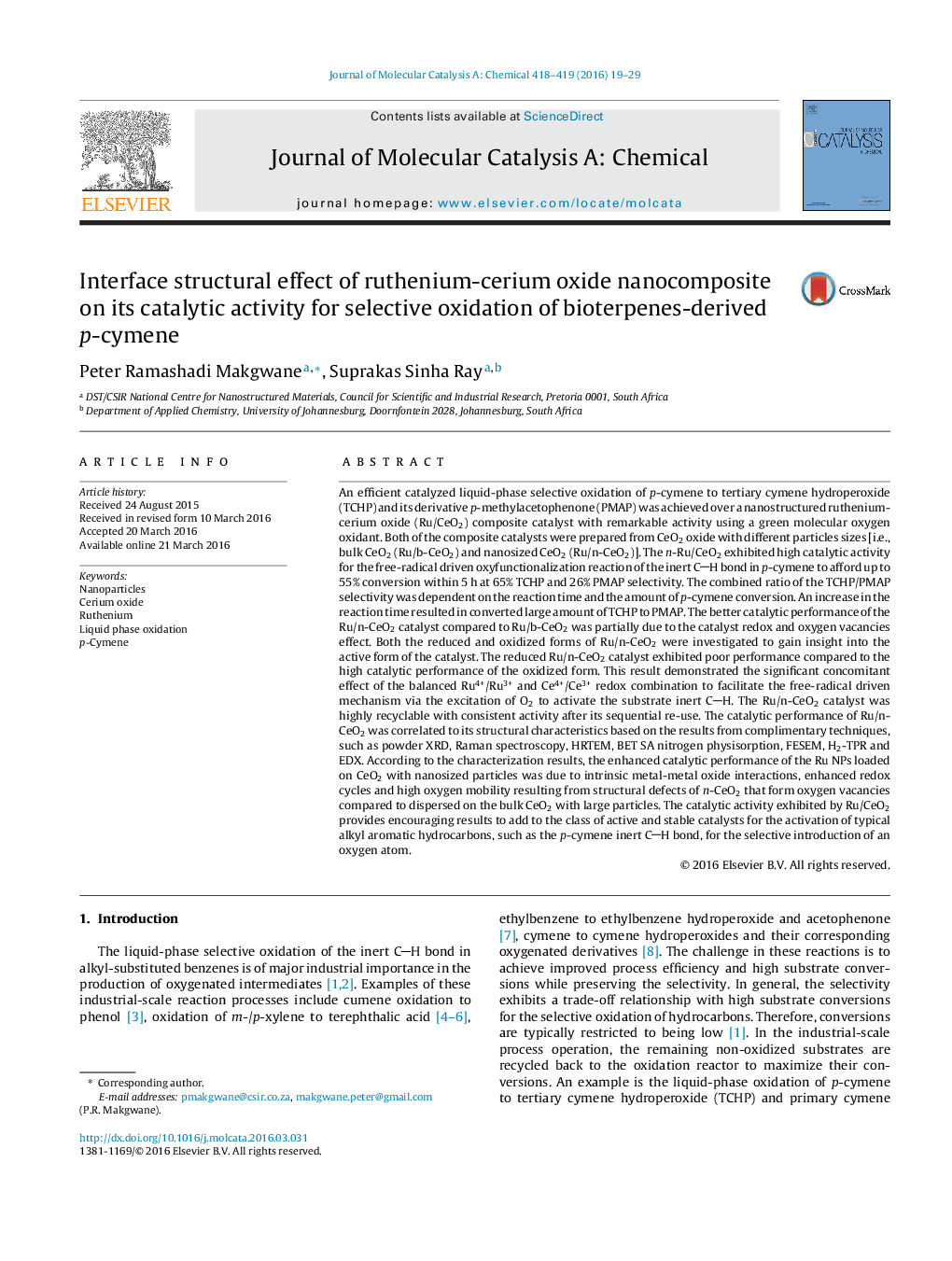| کد مقاله | کد نشریه | سال انتشار | مقاله انگلیسی | نسخه تمام متن |
|---|---|---|---|---|
| 64664 | 48365 | 2016 | 11 صفحه PDF | دانلود رایگان |

• Nano-dispersed Ru catalysts on CeO2 of different sizes were synthesized.
• Nanostructured Ru/CeO2 catalysts are active for p-cymene liquid-phase oxidation.
• Structure interface of Ru and CeO2 induced vary catalytic performance.
• Ru dispersed on nanosized CeO2 support was more active than on bulk CeO2.
• Nano-Ru/CeO2 was stable and easily reusable.
An efficient catalyzed liquid-phase selective oxidation of p-cymene to tertiary cymene hydroperoxide (TCHP) and its derivative p-methylacetophenone (PMAP) was achieved over a nanostructured ruthenium-cerium oxide (Ru/CeO2) composite catalyst with remarkable activity using a green molecular oxygen oxidant. Both of the composite catalysts were prepared from CeO2 oxide with different particles sizes [i.e., bulk CeO2 (Ru/b-CeO2) and nanosized CeO2 (Ru/n-CeO2)]. The n-Ru/CeO2 exhibited high catalytic activity for the free-radical driven oxyfunctionalization reaction of the inert CH bond in p-cymene to afford up to 55% conversion within 5 h at 65% TCHP and 26% PMAP selectivity. The combined ratio of the TCHP/PMAP selectivity was dependent on the reaction time and the amount of p-cymene conversion. An increase in the reaction time resulted in converted large amount of TCHP to PMAP. The better catalytic performance of the Ru/n-CeO2 catalyst compared to Ru/b-CeO2 was partially due to the catalyst redox and oxygen vacancies effect. Both the reduced and oxidized forms of Ru/n-CeO2 were investigated to gain insight into the active form of the catalyst. The reduced Ru/n-CeO2 catalyst exhibited poor performance compared to the high catalytic performance of the oxidized form. This result demonstrated the significant concomitant effect of the balanced Ru4+/Ru3+ and Ce4+/Ce3+ redox combination to facilitate the free-radical driven mechanism via the excitation of O2 to activate the substrate inert CH. The Ru/n-CeO2 catalyst was highly recyclable with consistent activity after its sequential re-use. The catalytic performance of Ru/n-CeO2 was correlated to its structural characteristics based on the results from complimentary techniques, such as powder XRD, Raman spectroscopy, HRTEM, BET SA nitrogen physisorption, FESEM, H2-TPR and EDX. According to the characterization results, the enhanced catalytic performance of the Ru NPs loaded on CeO2 with nanosized particles was due to intrinsic metal-metal oxide interactions, enhanced redox cycles and high oxygen mobility resulting from structural defects of n-CeO2 that form oxygen vacancies compared to dispersed on the bulk CeO2 with large particles. The catalytic activity exhibited by Ru/CeO2 provides encouraging results to add to the class of active and stable catalysts for the activation of typical alkyl aromatic hydrocarbons, such as the p-cymene inert CH bond, for the selective introduction of an oxygen atom.
Figure optionsDownload high-quality image (184 K)Download as PowerPoint slide
Journal: Journal of Molecular Catalysis A: Chemical - Volumes 418–419, July 2016, Pages 19–29